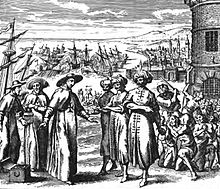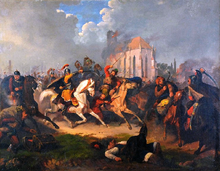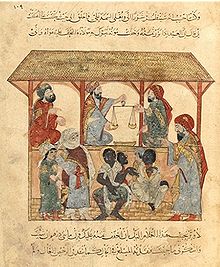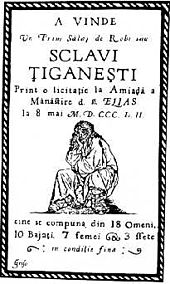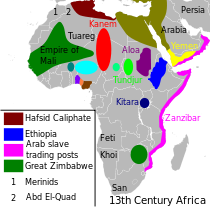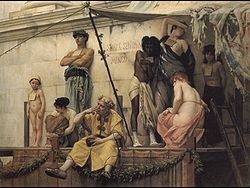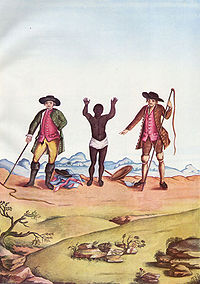- Slavery
-
"Slave" redirects here. For other uses, see Slave (disambiguation).
Part of a series on Slavery Contemporary slavery Types Unfree labour · Debt bondage
Human trafficking · Peonage
Penal labour · Sexual slavery
Wage slaveryHistory History · Antiquity · Aztec
Ancient Greece · Rome
Medieval Europe
Thrall · Kholop · Serfdom
Slave ship · Galley slaveReligion The Bible · Judaism
Christianity · IslamBy country or region Africa · Modern Africa
Atlantic · Arab
Barbary Coast · Coastwise
Spanish New World
Angola · Bhutan · Brazil
Britain and Ireland
British Virgin Islands · Canada
China · India · Iran · Japan
Libya · Mauritania · Ottoman empire
Portugal · Romania · Seychelles
Sudan · Sweden · United StatesOpposition and resistance Timeline · Abolitionism
Compensated emancipation
Opponents of slavery
Slave rebellion · Slave narrative
Underground RailroadSlavery is a system under which people are treated as property and are forced to work.[1] Slaves can be held against their will from the time of their capture, purchase or birth, and deprived of the right to leave, to refuse to work, or to demand compensation. Conditions that can be considered slavery include debt bondage, indentured servitude, serfdom, domestic servants kept in captivity, adoption in which children are effectively forced to work as slaves, child soldiers, and forced marriage.[2]
Slavery predates written records and has existed in many cultures.[3] The number of slaves today is higher than at any point in history,[4] remaining as high as 12 million[5] to 27 million,[6][7][8] though this is probably the smallest proportion of the world's population in history.[9] Most are debt slaves, largely in South Asia, who are under debt bondage incurred by lenders, sometimes even for generations.[10] Human trafficking is primarily used for forcing women and children into sex industries.[11]
Contents
Etymology
The English word slave comes from Old French sclave < Medieval Latin sclavus < Byzantine Greek σκλάβος.
The word σκλάβος comes from the ethnonym 'Slav';[12][13] an older theory connected it to the Greek verb skyleúo 'to strip a slain enemy'.[14]
Types
Photograph of a slave boy in Zanzibar. 'An Arab master's punishment for a slight offence.' c. 1890.
Chattel slavery
Chattel slavery, so named because people are treated as the personal property of an owner and are bought and sold as commodities, is the traditional form of slavery. It is the least prevalent form of slavery today.[10]
Bonded labor
Main article: Bonded laborDebt bondage or bonded labor is when a person pledges themselves against a loan.[15] In debt bondage, the services required to repay the debt may be undefined, and the services' duration may be undefined.[15] Debt bondage can be passed on from generation to generation.[15] It is the most widespread form of slavery today.[10]
Human trafficking
Main article: Human traffickingHuman trafficking is the illegal trade in human beings to work as slaves.[10]
Forced labor
Main article: Forced laborForced labor is when an individual is forced to work against their will, under threat of violence or other punishment, with restrictions on their freedom.[10] It is also used to describe all types of slavery and may also include institutions not commonly classified as slavery, such as serfdom, conscription and penal labor.
History
Main article: History of slaveryEarly history
Evidence of slavery predates written records, and has existed in many cultures.[3] Prehistoric graves from about 8000 BC in Lower Egypt suggest that a Libyan people enslaved a San[disambiguation needed
 ]-like tribe.[16] Slavery is rare among hunter–gatherer populations, as slavery is a system of social stratification. Mass slavery also requires economic surpluses and a high population density to be viable. Due to these factors, the practice of slavery would have only proliferated after the invention of agriculture during the Neolithic Revolution about 11,000 years ago.[17]
]-like tribe.[16] Slavery is rare among hunter–gatherer populations, as slavery is a system of social stratification. Mass slavery also requires economic surpluses and a high population density to be viable. Due to these factors, the practice of slavery would have only proliferated after the invention of agriculture during the Neolithic Revolution about 11,000 years ago.[17]The earliest records of slavery can be traced to the oldest known records, which treat it as an established institution, not one newly instituted. The Code of Hammurabi (ca. 1760 BC), for example, stated that death was prescribed for anyone who helped a slave to escape, as well as for anyone who sheltered a fugitive.[18] The Bible refers to slavery as an established institution.[3]
Slavery was known in civilizations as old as Sumer, as well as almost every other ancient civilization, including Ancient Egypt, Ancient China, the Akkadian Empire, Assyria, Ancient India, Ancient Greece, the Roman Empire, the Islamic Caliphate, and the pre-Columbian civilizations of the Americas.[3] Such institutions were a mixture of debt-slavery, punishment for crime, the enslavement of prisoners of war, child abandonment, and the birth of slave children to slaves.[19]
Classical Antiquity
Main articles: Slavery in ancient Greece and Slavery in ancient RomeRecords of slavery in Ancient Greece go as far back as Mycenaean Greece. It is certain that Classical Athens had the largest slave population, with as many as 80,000 in the 6th and 5th centuries BC,[20] on average three or four slaves per household.[21] As the Roman Republic expanded outward, entire populations were enslaved, thus creating an ample supply from all over Europe and the Mediterranean. Greeks, Illyrians, Berbers, Germans, Britons, Thracians, Gauls, Jews, Arabs, and many more were slaves used not only for labour, but also for amusement (e.g. gladiators and sex slaves). This oppression by an elite minority eventually led to slave revolts (see Roman Servile Wars); the Third Servile War led by Spartacus being the most famous and severe. By the late Republican era, slavery had become a vital economic pillar in the wealth of Rome, as well as a very significant part of Roman society.[22] At the least, some 25% of the population of Ancient Rome was enslaved.[23] According to some scholars, slaves represented 35% or more of Italy's population.[24] In the city of Rome alone, under the Roman Empire, there were about 400,000 slaves.[25] During the millennium from the emergence of the Roman Empire to its eventual decline, at least 100 million people were captured or sold as slaves throughout the Mediterranean and its hinterlands.[26]
Middle Ages
Medieval Europe
Main article: Slavery in medieval EuropeFurther information: SerfdomThe early medieval slave trade was mainly confined to the South and East: the Byzantine Empire and the Muslim world were the destinations, pagan Central and Eastern Europe, along with the Caucasus and Tartary, were important sources. Viking, Arab, Greek and Jewish merchants (known as Radhanites) were all involved in the slave trade during the Early Middle Ages.[27][28][29] The trade in European slaves reached a peak in the 10th century following the Zanj rebellion which dampened the use of African slaves in the Arab world.[30][31][32]
Medieval Spain and Portugal were the scene of almost constant Muslim invasion of the predominantly Christian area. Periodic raiding expeditions were sent from Al-Andalus to ravage the Iberian Christian kingdoms, bringing back booty and slaves. In raid against Lisbon, Portugal in 1189, for example, the Almohad caliph Yaqub al-Mansur took 3,000 female and child captives, while his governor of Córdoba, in a subsequent attack upon Silves, Portugal in 1191, took 3,000 Christian slaves.[33] From the 11th to the 19th century, North African Barbary Pirates engaged in Razzias, raids on European coastal towns, to capture Christian slaves to sell at slave markets in places such as Algeria and Morocco.[34][35]
 Depiction of socage on the royal demesne in feudal England (miniature from Queen Mary's Psalter, ca. 1310). Socage is an aspect of serfdom, not usually included under the term "slavery".
Depiction of socage on the royal demesne in feudal England (miniature from Queen Mary's Psalter, ca. 1310). Socage is an aspect of serfdom, not usually included under the term "slavery".
At the time of the Domesday Book, compiled in 1086, nearly 10% of the English population were slaves.[36] Slavery in early medieval Europe was so common that the Roman Catholic Church repeatedly prohibited it — or at least the export of Christian slaves to non-Christian lands was prohibited at e.g. the Council of Koblenz (922), the Council of London (1102), and the Council of Armagh (1171).[37] In 1452, Pope Nicholas V issued the papal bull Dum Diversas, granting Afonso V of Portugal the right to reduce any "Saracens, pagans and any other unbelievers" to hereditary slavery which legitimized the slave trade, at least as a result of war.[38] The approval of slavery under these conditions was reaffirmed and extended in his Romanus Pontifex bull of 1455. However, Pope Paul III forbade enslavement of the Indians in 1537 in his papal bull Sublimus Dei.[39] Dominican friars who arrived at the Spanish settlement at Santo Domingo strongly denounced the enslavement of the local Indians. Along with other priests, they opposed their treatment as unjust and illegal in an audience with the Spanish king and in the subsequent royal commission.[40]
The Byzantine-Ottoman wars and the Ottoman wars in Europe brought large numbers of slaves into the Islamic world.[41] From the mid to late 14th, through early 18th centuries, the Ottoman devşirme–janissary system enslaved and forcibly converted to Islam an estimated 500,000 to one million non–Muslim (primarily Balkan Christian) adolescent males.[42] After the Battle of Lepanto approximately 12,000 Christian galley slaves were freed from the Ottoman fleet.[43] Eastern Europe suffered a series of Tatar invasions, the goal of which was to loot and capture slaves into jasyr. Seventy-five Crimean Tatar raids were recorded into Poland–Lithuania between 1474–1569.[44] There were more than 100,000 Russian captives in the Kazan Khanate alone in 1551.[45]
Approximately 10–20% of the rural population of Carolingian Europe consisted of slaves.[47] In Western Europe slavery largely disappeared by the later Middle Ages.[48] The trade of slaves in England was made illegal in 1102.[49] Thralldom in Scandinavia was finally abolished in the mid-14th century.[50] Slavery persisted longer in Eastern Europe. Slavery in Poland was forbidden in the 15th century; in Lithuania, slavery was formally abolished in 1588; they were replaced by the second serfdom. In Kievan Rus and Muscovy, the slaves were usually classified as kholops.
Islamic world
In early Islamic states of the western Sudan, including Ghana (750–1076), Mali (1235–1645), Segou (1712–1861), and Songhai (1275–1591), about a third of the population were enslaved.
Ibn Battuta tells us several times that he was given or purchased slaves.[52] The great 14th-century scholar Ibn Khaldun, wrote: "the Black nations are, as a rule, submissive to slavery, because (Blacks) have little that is (essentially) human and possess attributes that are quite similar to those of dumb animals".[53] Slaves were purchased or captured on the frontiers of the Islamic world and then imported to the major centers, where there were slave markets from which they were widely distributed.[54][55][56] In the 9th and 10th centuries, the black Zanj slaves may have constituted at least a half of the total population in lower Iraq.[57] At the same time, many tens of thousands of slaves in the region were also imported from Central Asia and the Caucasus.[58]
Modern history
Europe
Slavery remained a major institution in Russia until 1723, when the Peter the Great converted the household slaves into house serfs. Russian agricultural slaves were formally converted into serfs earlier in 1679.[59] Russia's more than 23 million privately held serfs were freed from their lords by an edict of Alexander II in 1861.[60] State owned serfs were emancipated in 1866.[61]
Africa
Main article: African slave tradeIn Senegambia, between 1300 and 1900, close to one-third of the population was enslaved. In Sierra Leone in the 19th century about half of the population consisted of enslaved people.[62]
In the 19th century at least half the population was enslaved among the Duala of the Cameroon, the Igbo and other peoples of the lower Niger, the Kongo, and the Kasanje kingdom and Chokwe of Angola. Among the Ashanti and Yoruba a third of the population consisted of enslaved people.[62]
The population of the Kanem (1600–1800) was about a third-enslaved. It was perhaps 40% in Bornu (1580–1890). Between 1750 and 1900 from one- to two-thirds of the entire population of the Fulani jihad states consisted of slaves.[62]
The population of the Sokoto caliphate formed by Fulanis and Hausas in northern Nigeria and Cameroon was half-slave in the 19th century. Between 65% to 90% population of Arab-Swahili Zanzibar was enslaved.[62] The Swahili-Arab slave trade reached its height about 150 years ago, when, for example, approximately 20,000 slaves were considered to be carried yearly from Nkhotakota on Lake Malawi to Kilwa.[63] Roughly half the population of Madagascar was enslaved.[62][64]
According to the Encyclopedia of African History, "It is estimated that by the 1890s the largest slave population of the world, about 2 million people, was concentrated in the territories of the Sokoto Caliphate. The use of slave labor was extensive, especially in agriculture."[65][66] The Anti-Slavery Society estimated there were 2 million slaves in Ethiopia in the early 1930s out of an estimated population of between 8 and 16 million.[67]
Hugh Clapperton in 1824 believed that half the population of Kano were enslaved people.[68] According to W. A. Veenhoven, "The German doctor, Gustav Nachtigal, an eye-witness, believed that for every slave who arrived at a market three or four died on the way... Keltie (The Partition of Africa, London, 1920) believes that for every slave the Arabs brought to the coast at least six died on the way or during the slavers' raid. Livingstone puts the figure as high as ten to one."[69]
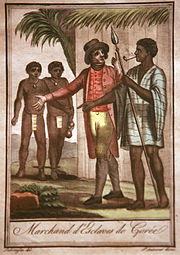 Slave traders in Gorée, Senegal, 18th century
Slave traders in Gorée, Senegal, 18th century
One of the most famous slave traders on the East African coast was Tippu Tip, who was himself the grandson of an enslaved African. The prazeros slave traders, descendants of Portuguese and Africans, operated along the Zambezi. North of the Zambezi, the waYao and Makua people played a similar role as professional slave raiders and traders. The Nyamwezi slave traders operated further north under the leadership of Msiri and Mirambo.[70]
Asia
As late as 1908, women slaves were still sold in the Ottoman Empire.[71] A slave market for captured Russian and Persian slaves was centred in the Central Asian khanate of Khiva.[72] According to Sir Henry Bartle Frere (who sat on the Viceroy's Council), there were an estimated 8 million or 9 million slaves in India in 1841. In Malabar, about 15% of the population were slaves. Slavery was abolished in British India by the Indian Slavery Act V. of 1843.[3][73] In Istanbul about one-fifth of the population consisted of slaves.[74]
In East Asia, the Imperial government formally abolished slavery in China in 1906, and the law became effective in 1910.[75] Slave rebellion in China at the end of the 17th and the beginning of the 18th century was so extensive that owners eventually converted the institution into a female-dominated one.[76] The Nangzan in Tibetan history were, according to Chinese sources, hereditary household slaves.[77]
Indigenous slaves existed in Korea. Slavery was officially abolished with the Gabo Reform of 1894 but remained extant in reality until 1930. During the Joseon Dynasty (1392–1910) about 30% to 50% of the Korean population were slaves.[78] In late 16th century Japan, slavery was officially banned; but forms of contract and indentured labor persisted alongside the period penal codes' forced labor.[79]
In Southeast Asia, a quarter to a third of seventeenth- to twentieth-century populations in some areas of Thailand and Burma were slaves.[3] The hill tribe people in Indochina were "hunted incessantly and carried off as slaves by the Siamese (Thai), the Anamites (Vietnamese), and the Cambodians."[80] A Siamese military campaign in Laos in 1876 was described by a British observer as having been "transformed into slave-hunting raids on a large scale".[81]
Americas
Main article: Atlantic slave tradeFurther information: Slavery in Brazil and Slavery in the United StatesSlavery in the Americas had a contentious history, dating back at least to the Aztecs,[82] and played a major role in the history and evolution of some countries, triggering at least one revolution and one civil war, as well as numerous rebellions.
Slavery was prominent in Africa, across the Atlantic Ocean from the Americas, long before the beginnings of the transatlantic slave trade.[74] The maritime town of Lagos, Portugal, Europe, was the first slave market created in Portugal (one of the earliest colonizers of the Americas) for the sale of imported African slaves – the Mercado de Escravos, opened in 1444.[83][84] In 1441, the first slaves were brought to Portugal from northern Mauritania.[84]
By 1552 black African slaves made up 10 percent of the population of Lisbon.[85][86] In the second half of the 16th century, the Crown gave up the monopoly on slave trade and the focus of European trade in African slaves shifted from import to Europe to slave transports directly to tropical colonies in the Americas – in the case of Portugal, especially Brazil.[84] In the 15th century one third of the slaves were resold to the African market in exchange of gold.[87]
Spain had to fight against the relatively powerful civilizations of the New World. The Spanish conquest of the indigenous peoples in the Americas included using the Natives as forced labour, part of the wider Atlantic slave trade. The Spanish colonies were the first Europeans to use African slaves in the New World on islands such as Cuba and Hispaniola,.[88]
 The public flogging of a slave in Rio de Janeiro, Brazil. From Jean Baptiste Debret, Voyage Pittoresque et Historique au Bresil (1834–1839).
The public flogging of a slave in Rio de Janeiro, Brazil. From Jean Baptiste Debret, Voyage Pittoresque et Historique au Bresil (1834–1839).
Bartolomé de Las Casas a 16th-century Dominican friar and Spanish historian participated in campaigns in Cuba (at Bayamo and Camagüey) and was present at the massacre of Hatuey; his observation of that massacre led him to fight for a social movement away from the use of natives as slaves and towards the importation of African Blacks as slaves. Also, the alarming decline in the native population had spurred the first royal laws protecting the native population (Laws of Burgos, 1512–1513).
The first African slaves arrived in Hispaniola in 1501.[89] In 1518, Charles I of Spain agreed to ship slaves directly from Africa. England played a prominent role in the Atlantic slave trade. The "slave triangle" was pioneered by Francis Drake and his associates. A black man named Anthony Johnson of Virginia first introduced permanent black slavery in the 1650s by becoming the first holder in America of permanent black slaves.[90] By 1750, slavery was a legal institution in all of the 13 American colonies,[91][92] and the profits of the slave trade and of West Indian plantations amounted to 5% of the British economy at the time of the Industrial Revolution. [93]
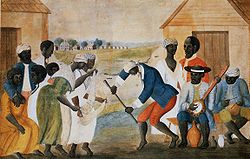 Slaves on a Virginia plantation (The Old Plantation, c. 1790).
Slaves on a Virginia plantation (The Old Plantation, c. 1790).
The Transatlantic slave trade peaked in the late 18th century, when the largest number of slaves were captured on raiding expeditions into the interior of West Africa. These expeditions were typically carried out by African kingdoms, such as the Oyo empire (Yoruba), the Ashanti Empire,[94] the kingdom of Dahomey,[95] and the Aro Confederacy.[96] Europeans rarely entered the interior of Africa, due to fierce African resistance. The slaves were brought to coastal outposts where they were traded for goods.
An estimated 12 million Africans arrived in the Americas from the 16th to the 19th centuries.[97] Of these, an estimated 645,000 were brought to what is now the United States. The usual estimate is that about 15 per cent of slaves died during the voyage, with mortality rates considerably higher in Africa itself in the process of capturing and transporting indigenous peoples to the ships. Approximately 6 million Africans were killed by other blacks in tribal wars.[98]
The white citizens of Virginia decided to treat the first Africans in Virginia as indentured servants.[99] Over half of all European immigrants to Colonial America during the 17th and 18th centuries arrived as indentured servants.[100] In 1655, John Casor, a black man, became the first legally recognized slave in the present United States.[101] According to the 1860 U.S. census, 393,975 individuals, representing 8% of all US families, owned 3,950,528 slaves.[102] One-third of Southern families owned slaves.[103]
The largest number of slaves were shipped to Brazil.[104] In the Spanish viceroyalty of New Granada, corresponding mainly to modern Panama, Colombia, and Venezuela, the free black population in 1789 was 420,000, whereas African slaves numbered only 20,000. Free blacks also outnumbered slaves in Brazil. In Cuba, by contrast, free blacks made up only 15% in 1827; and in the French colony of Saint-Domingue (present-day Haiti) it was a mere 5% in 1789.[105] Some half-million slaves, most of them born in Africa, worked the booming plantations of Saint-Domingue.[106]
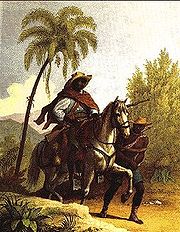 The Brazilian slave-hunter, 1823, by Johann Moritz Rugendas.
The Brazilian slave-hunter, 1823, by Johann Moritz Rugendas.
Author Charles Rappleye argued that
“ In the West Indies in particular, but also in North and South America, slavery was the engine that drove the mercantile empires of Europe..It appeared, in the eighteenth century, as universal and immutable as human nature.[107] ” Although the trans-Atlantic slave trade ended shortly after the American Revolution, slavery remained a central economic institution in the Southern states of the United States, from where slavery expanded with the westward movement of population.[108] Historian Peter Kolchin wrote, "By breaking up existing families and forcing slaves to relocate far from everyone and everything they knew" this migration "replicated (if on a reduced level) many of [the] horrors" of the Atlantic slave trade.[109]
Historian Ira Berlin called this forced migration the Second Middle Passage. Characterizing it as the "central event" in the life of a slave between the American Revolution and the Civil War, Berlin wrote that whether they were uprooted themselves or simply lived in fear that they or their families would be involuntarily moved, "the massive deportation traumatized black people, both slave and free."[110]
By 1860, 500,000 slaves had grown to 4 million. As long as slavery expanded, it remained profitable and powerful and was unlikely to disappear. Although complete statistics are lacking, it is estimated that 1,000,000 slaves moved west from the Old South between 1790 and 1860.[111]
Most of the slaves were moved from Maryland, Virginia, and the Carolinas. Michael Tadman, in a 1989 book Speculators and Slaves: Masters, Traders, and Slaves in the Old South, indicates that 60–70% of interregional migrations were the result of the sale of slaves. In 1820 a child in the Upper South had a 30% chance to be sold south by 1860.[111]
Islamic world
Main article: Arab slave tradeSee also: Slavery (Ottoman Empire), Islam and slavery, and Slavery on the Barbary Coast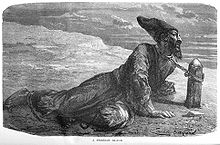 Persian slave in the Khanate of Khiva, 19th century
Persian slave in the Khanate of Khiva, 19th century
According to Robert Davis between 1 million and 1.25 million Europeans were captured by Barbary pirates and sold as slaves in North Africa and Ottoman Empire between the 16th and 19th centuries.[112][113] There was also an extensive trade in Christian slaves in the Black Sea region for several centuries until the Crimean Khanate was destroyed by the Russian Empire in 1783.[45] In the 1570s close to 20,000 slaves a year were being sold in the Crimean port of Kaffa.[114] The slaves were captured in southern Russia, Poland-Lithuania, Moldavia, Wallachia, and Circassia by Tatar horsemen in a trade known as the "harvesting of the steppe". In Podolia alone, about one-third of all the villages were destroyed or abandoned between 1578 and 1583.[115] Some researchers estimate that altogether more than 3 million people were captured and enslaved during the time of the Crimean Khanate.[116][117] It is estimated that up to 75% of the Crimean population consisted of slaves or freedmen.[74]
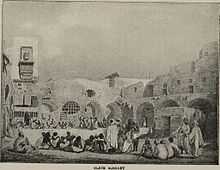 A slave market in Cairo. c.1830
A slave market in Cairo. c.1830
Historians say the Arab slave trade lasted more than a millennium.[118] As recently as the early 1960s, Saudi Arabia’s slave population was estimated at 300,000.[119] Along with Yemen, the Saudis only abolished slavery in 1962.[120] Slaves in the Arab World came from many different regions, including Sub-Saharan Africa (mainly Zanj),[121] the Caucasus (mainly Circassians),[122] Central Asia (mainly Tartars), and Central and Eastern Europe (mainly Saqaliba).[123]
Under Omani Arabs Zanzibar became East Africa's main slave port, with as many as 50,000 enslaved Africans passing through every year during the 19th century.[124][125] Some historians estimate that between 11 and 18 million African slaves crossed the Red Sea, Indian Ocean, and Sahara Desert from 650 AD to 1900 AD.[3][126][127] Eduard Rüppell described the heavy mortality of the enslaved Sudanese before reaching Egypt: "after the Daftardar bey's 1822 campaign in the southern Nuba mountains, nearly 40,000 slaves were captured. However, through bad treatment, disease and desert travel barely 5000 made it to Egypt."[128]
Central and Eastern European slaves were generally known as Saqaliba (i.e., Slavs).[129] The Moors, starting in the 8th century, also raided coastal areas around the Mediterranean and Atlantic Ocean, and became known as the Barbary pirates.[130] It is estimated that they captured 1.25 million white slaves from Western Europe and North America between the 16th and 19th centuries.[131][132] The mortality rate was very high. For instance, when plague broke out in Algiers' overcrowded slave pens in 1662, some said that it carried off 10,000–20,000 of the city's 30,000 captives.[133]
Present day
 Francis Bok, former Sudanese slave. It is estimated that as many as 200,000 people had been enslaved during the Second Sudanese Civil War. The slaves are mostly Dinka people.[134][135]
Francis Bok, former Sudanese slave. It is estimated that as many as 200,000 people had been enslaved during the Second Sudanese Civil War. The slaves are mostly Dinka people.[134][135]
There are more slaves today than at any point in history,[4] remaining as high as 12 million[5] to 27 million,[6][7][8] even though slavery is now outlawed in all countries.[7][136] Several estimates of the number of slaves in the world have been provided. According to a broad definition of slavery used by Kevin Bales of Free the Slaves (FTS), an advocacy group linked with Anti-Slavery International, there were 27 million people in slavery in 1999, spread all over the world.[137] In 2005, the International Labour Organization provided an estimate of 12.3 million forced labourers in the world,.[138] Thanks to the ILO Special Action Programme to Combat Forced Labour (SAP-FL), the work of the ILO has been spearheaded in this field since early 2002. The Programme has successfully raised global awareness and understanding of modern forced labour; assisted governments to develop and implement new laws, policies and action plans; developed and disseminated guidance and training materials on key aspects of forced labour and human trafficking; implemented innovative programmes which combine policy development, capacity building of law enforcement and labour market institutions, and targeted, field-based projects of direct support for both prevention of forced labour and identification and rehabilitation of its victims. Siddharth Kara has also provided an estimate of 28.4 million slaves at the end of 2006 divided into the following three categories: bonded labour/debt bondage (18.1 million), forced labour (7.6 million), and trafficked slaves (2.7 million).[139] Kara provides a dynamic model to calculate the number of slaves in the world each year, with an estimated 29.2 million at the end of 2009.
The Middle East Quarterly reports that slavery is still endemic in Sudan.[140] In June and July 2007, 570 people who had been enslaved by brick manufacturers in Shanxi and Henan were freed by the Chinese government.[141] Among those rescued were 69 children.[142] In response, the Chinese government assembled a force of 35,000 police to check northern Chinese brick kilns for slaves, sent dozens of kiln supervisors to prison, punished 95 officials in Shanxi province for dereliction of duty, and sentenced one kiln foreman to death for killing an enslaved worker.[141] In 2008, the Nepalese government abolished the Haliya system of forced labour, freeing about 20,000 people.[143] An estimated 40 million people in India, most of them Dalits or "untouchables", are bonded workers, working in slave-like conditions in order to pay off debts.[144][145][146] Though slavery was officially abolished in China in 1910,[147] the practice continues unofficially in some regions of the country.[148][149][150] In Brazil more than 5,000 slaves were rescued by authorities in 2008 as part of a government initiative to eradicate slavery.[151]
In Mauritania, the last country to abolish slavery (in 1981),[153] it is estimated that up to 600,000 men, women and children, or 20% of the population, are enslaved with many used as bonded labour.[154][155] Slavery in Mauritania was criminalized in August 2007.[156] In Niger, slavery is also a current phenomenon. A Nigerien study has found that more than 800,000 people are enslaved, almost 8% of the population.[157][158][159] Pygmies, the people of Central Africa's rain forest,[160] live in servitude to the Bantus.[161] Some tribal sheiks in Iraq still keep blacks, called Abd, which means servant or slave in Arabic, as slaves.[162] Child slavery has commonly been used in the production of cash crops and mining. According to the U.S. Department of State, more than 109,000 children were working on cocoa farms alone in Côte d'Ivoire (Ivory Coast) in "the worst forms of child labor" in 2002.[163] Poverty has forced at least 225,000 Haitian children to work as restavecs (unpaid household servants); the United Nations considers this to be a modern-day form of slavery.[164]
Trafficking in human beings (also called human trafficking) is one method of obtaining slaves. Victims are typically recruited through deceit or trickery (such as a false job offer, false migration offer, or false marriage offer), sale by family members, recruitment by former slaves, or outright abduction. Victims are forced into a "debt slavery" situation by coercion, deception, fraud, intimidation, isolation, threat, physical force, debt bondage or even force-feeding with drugs of abuse to control their victims.[165] "Annually, according to U.S. Government-sponsored research completed in 2006, approximately 800,000 people are trafficked across national borders, which does not include millions trafficked within their own countries. Approximately 80 percent of transnational victims are women and girls and up to 50 percent are minors," reports the U.S. Department of State in a 2008 study.[166]
While the majority of victims are women, and sometimes children, who are forced into prostitution (in which case the practice is called sex trafficking), victims also include men, women and children who are forced into manual labour.[167] Due to the illegal nature of human trafficking, its exact extent is unknown. A U.S. Government report published in 2005, estimates that 600,000 to 800,000 people worldwide are trafficked across borders each year. This figure does not include those who are trafficked internally.[167] Another research effort revealed that between 1.5 million and 1.8 million individuals are trafficked either internally or internationally each year, 500,000 to 600,000 of whom are sex trafficking victims.[139]
Abolitionism
Main article: AbolitionismSee also: Abolition of slavery timelineThe painting of the 1840 Anti-Slavery Society Convention at Exeter Hall. Move your cursor to identify delegates or click the icon to enlarge.[168]
Slavery has existed, in one form or another, through the whole of recorded human history — as have, in various periods, movements to free large or distinct groups of slaves.
The Greek Stoics advocated the brotherhood of humanity and the natural equality of all human beings, and consistently critiqued slavery as against the law of nature.[169] Emperor Wang Mang abolishes slave trading (although not slavery) in China in 9 CE.[170]
The Spanish colonization of the Americas sparked a discussion about the right to enslave native Americans. A prominent critic of slavery in the Spanish New World colonies was Bartolomé de las Casas, who opposed the enslavement of Native Americans, and later also of Africans in America.
One of the first protests against the enslavement of Africans came from German and Dutch Quakers in Pennsylvania in 1688. One of the most significant milestones in the campaign to abolish slavery throughout the world occurred in England in 1772, with British judge Lord Mansfield, whose opinion in Somersett's Case was widely taken to have held that slavery was illegal in England. This judgement also laid down the principle that slavery contracted in other jurisdictions (such as the American colonies) could not be enforced in England.[171] In 1777, Vermont became the first portion of what would become the United States to abolish slavery (at the time Vermont was an independent nation). In 1794, under the Jacobins, Revolutionary France abolished slavery.[172] There were celebrations in 2007 to commemorate the 200th anniversary of the Abolition of the slave trade in the United Kingdom through the work of the British Anti-Slavery Society.
 Joseph Jenkins Roberts, born in Virginia, was the first president of Liberia, which was founded in 1822 for freed American slaves.
Joseph Jenkins Roberts, born in Virginia, was the first president of Liberia, which was founded in 1822 for freed American slaves.
William Wilberforce received much of the credit although the groundwork was an anti-slavery essay by Thomas Clarkson. Wilberforce was also urged by his close friend, Prime Minister William Pitt the Younger, to make the issue his own, and was also given support by reformed Evangelical John Newton. The Slave Trade Act was passed by the British Parliament on 25 March 1807, making the slave trade illegal throughout the British Empire, Wilberforce also campaigned for abolition of slavery in the British Empire, which he lived to see in the Slavery Abolition Act 1833. After the 1807 act abolishing the slave trade was passed, these campaigners switched to encouraging other countries to follow suit, notably France and the British colonies. In 1839, the world's oldest international human rights organization, Anti-Slavery International, was formed in Britain by Joseph Sturge, which campaigned to outlaw slavery in other countries.[173]
Between 1808 and 1860, the British West Africa Squadron seized approximately 1,600 slave ships and freed 150,000 Africans who were aboard.[174] Action was also taken against African leaders who refused to agree to British treaties to outlaw the trade, for example against "the usurping King of Lagos", deposed in 1851. Anti-slavery treaties were signed with over 50 African rulers.[175]
 Three people in chains, probably somewhere in East-Africa. By 1900, slaves comprised up to one-third of Ethiopia's population.[176] Emperor Haile Selassie officially abolished slavery in 1942.
Three people in chains, probably somewhere in East-Africa. By 1900, slaves comprised up to one-third of Ethiopia's population.[176] Emperor Haile Selassie officially abolished slavery in 1942.
In the United States, abolitionist pressure produced a series of small steps towards emancipation. After January 1, 1808, the importation of slaves into the United States was prohibited,[177] but not the internal slave trade, nor involvement in the international slave trade externally. Legal slavery persisted; and those slaves already in the U.S. would not be legally emancipated for nearly 60 years. Many American abolitionists took an active role in opposing slavery by supporting the Underground Railroad. Violence soon erupted, with the anti-slavery forces led by John Brown, and Bleeding Kansas, involving anti-slavery and pro-slavery settlers, became a symbol for the nationwide clash over slavery. By 1860 the total number of slaves reached almost four million, and the American Civil War, beginning in 1861, led to the end of slavery in the United States.[178]
In 1863 Lincoln issued the Emancipation Proclamation, which freed slaves held in the Confederate States; the 13th Amendment to the U.S. Constitution (1865) prohibited slavery throughout the country.
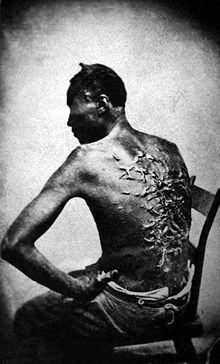 Photographed in 1863 – Peter, a man who was enslaved in Baton Rouge, Louisiana, whose scars are a result of a whipping by his overseer, who was subsequently discharged by Peter's owner. The pattern of scarring seen here is highly suggestive of keloid formation and not necessarily due to a particularly brutal flogging.
Photographed in 1863 – Peter, a man who was enslaved in Baton Rouge, Louisiana, whose scars are a result of a whipping by his overseer, who was subsequently discharged by Peter's owner. The pattern of scarring seen here is highly suggestive of keloid formation and not necessarily due to a particularly brutal flogging.
In the 1860s, David Livingstone's reports of atrocities within the Arab slave trade in Africa stirred up the interest of the British public, reviving the flagging abolitionist movement. The Royal Navy throughout the 1870s attempted to suppress "this abominable Eastern trade", at Zanzibar in particular.
On December 10, 1948, the United Nations General Assembly adopted the Universal Declaration of Human Rights, which declared freedom from slavery is an internationally recognized human right. Article 4 of the Universal Declaration of Human Rights states:
“ No one shall be held in slavery or servitude; slavery and the slave trade shall be prohibited in all their forms.[179] ” Groups such as the American Anti-Slavery Group, Anti-Slavery International, Free the Slaves, the Anti-Slavery Society, and the Norwegian Anti-Slavery Society continue to campaign to rid the world of slavery.
Legal actions
In November 2006, the International Labour Organization announced it will be seeking "to prosecute members of the ruling Myanmar junta for crimes against humanity" over the continuous forced labour of its citizens by the military at the International Court of Justice.[180][181] According to the International Labor Organization (ILO), an estimated 800,000 people are subject to forced labour in Myanmar.[182] It is estimated that in the last fifty years 40-50 million people have been sent to laogai, the system of forced labor camps in the People's Republic of China.[183]
The Ecowas Court of Justice is hearing the case of Hadijatou Mani in late 2008, where Ms. Mani hopes to compel the government of Niger to end slavery in its jurisdiction. Cases brought by her in local courts have failed so far.[184]
Economics
Economists have attempted to model during which circumstances slavery (and variants such as serfdom) appear and disappear. One observation is that slavery becomes more desirable for land owners when land is abundant but labour is not, so paid workers can demand high wages[citation needed]. If labour is abundant but land is scarce, then it becomes more costly for the land owners to have guards for the slaves than to employ paid workers who can only demand low wages due to the competition. Thus first slavery and then serfdom gradually decreased in Europe as the population grew[citation needed]. It was reintroduced in the Americas and in Russia (serfdom) as large new land areas with few people became available.[citation needed]. In his books, Time on the Cross and Without Consent or Contract: the Rise and Fall of American Slavery, Robert Fogel maintains that slavery was in fact a profitable method of production, especially on bigger plantations growing cotton that fetched high prices in the world market. It gave whites in the South higher average incomes than those in the North, but most of the money was spent on buying slaves and plantations.
Slavery is more common when the labour done is relatively simple and thus easy to supervise, such as large scale growing of a single crop. It is much more difficult and costly to check that slaves are doing their best and with good quality when they are doing complex tasks. Therefore, slavery was seen as the most efficient method of production for large scale crops like sugar and cotton, whose output was based on economies of scale. This enabled a gang system of labor to be prominent on large plantations where field hands were monitored and worked with factory-like precision. Each work gang was based on an internal division of labor that not only assigned every member of the gang to a precise task but simultaneously made his or her performance dependent on the actions of the others. The hoe hands chopped out the weeds that surrounded the cotton plants as well as excessive sprouts. The plow gangs followed behind, stirring the soil near the rows of cotton plants and tossing it back around the plants. Thus, the gang system worked like an early version of the assembly line later to be found in factories.[185]
Critics since the 18th century have argued that slavery tends to retard technological advancement, since the focus is on increasing the number of slaves doing simple tasks rather than upgrading the efficiency of labour. Because of this, theoretical knowledge and learning in Greece—and later in Rome—was not applied to ease physical labour or improve manufacturing.[186]
Adam Smith made the argument that free labor was economically better than slave labor, and argued further that slavery in Europe ended during the Middle Ages, and only then after both the church and state were separate, independent and strong institutions,[187] that it is nearly impossible to end slavery in a free, democratic and republican forms of governments since many of its legislators or political figures were slave owners, and would not punish themselves, and that slaves would be better able to gain their freedom when there was centralized government, or a central authority like a king or the church.[188] Similar arguments appear later in the works of Auguste Comte, especially when it comes to Adam Smith's belief in the separation of powers or what Comte called the "separation of the spiritual and the temporal" during the Middle Ages and the end of slavery, and Smith's criticism of masters, past and present. As Smith stated in the Lectures on Jurisprudence, "The great power of the clergy thus concurring with that of the king set the slaves at liberty. But it was absolutely necessary both that the authority of the king and of the clergy should be great. Where ever any one of these was wanting, slavery still continues."
The weighted average global sales price of a slave is calculated to be approximately $340, with a high of $1,895 for the average trafficked sex slave, and a low of $40 to $50 for debt bondage slaves in part of Asia and Africa.[139] Worldwide slavery is a criminal offense but slave owners can get very high returns for their risk.[189] According to researcher Siddharth Kara, the profits generated worldwide by all forms of slavery in 2007 were $91.2 billion. That is second only to drug trafficking in terms of global criminal enterprises. The weighted average annual profits generated by a slave in 2007 was $3,175, with a low of an average $950 for bonded labor and $29,210 for a trafficked sex slave.[139] Approximately forty percent of all slave profits each year are generated by trafficked sex slaves, representing slightly more than 4 percent of the world's 29 million slaves.[139]
Robert E. Wright has developed a model that helps to predict when firms (individuals, companies) will be more likely to use slaves rather than wage workers, indentured servants, family members, or other types of laborers.[190]
Apologies
 Monument to the slaves in Zanzibar
Monument to the slaves in Zanzibar
On May 21, 2001, the National Assembly of France passed the Taubira law, recognizing slavery as a crime against humanity. Apologies on behalf of African nations, for their role in trading their countrymen into slavery, remain an open issue since slavery was practiced in Africa even before the first Europeans arrived and the Atlantic slave trade was performed with a high degree of involvement of several African societies. The black slave market was supplied by well-established slave trade networks controlled by local African societies and individuals.[191] Indeed, as already mentioned in this article, slavery persists in several areas of West Africa until the present day.
There is adequate evidence citing case after case of African control of segments of the trade. Several African nations such as the Calabar and other southern parts of Nigeria had economies depended solely on the trade. African peoples such as the Imbangala of Angola and the Nyamwezi of Tanzania would serve as middlemen or roving bands warring with other African nations to capture Africans for Europeans.[192]
Several historians have made important contributions to the global understanding of the African side of the Atlantic slave trade. By arguing that African merchants determined the assemblage of trade goods accepted in exchange for slaves, many historians argue for African agency and ultimately a shared responsibility for the slave trade.[193]
The issue of an apology is linked to reparations for slavery and is still being pursued by a number of entities across the world. For example, the Jamaican Reparations Movement approved its declaration and action Plan.
In September, 2006, it was reported[194] that the UK Government may issue a "statement of regret" over slavery, an act that was followed through by a "public statement of sorrow" from Tony Blair on November 27, 2006.[195]
On February 25, 2007 the state of Virginia resolved to 'profoundly regret' and apologize for its role in the institution of slavery. Unique and the first of its kind in the U.S., the apology was unanimously passed in both Houses as Virginia approached the 400th anniversary of the founding of Jamestown, where the first slaves were imported into North America in 1619.[196]
On August 24, 2007, Mayor Ken Livingstone of London, United Kingdom apologized publicly for Britain's role in colonial slave trade. "You can look across there to see the institutions that still have the benefit of the wealth they created from slavery," he said pointing towards the financial district. He claimed that London was still tainted by the horrors of slavery. Jesse Jackson praised Livingstone, and added that reparations should be made, one of his common arguments.[197]
On July 30, 2008, the United States House of Representatives passed a resolution apologizing for American slavery and subsequent discriminatory laws.[198] In June 2009, the US Senate passed a resolution apologizing to African-Americans for the "fundamental injustice, cruelty, brutality, and inhumanity of slavery".[199]
Reparations
Main article: Reparations for slaveryThere have been movements to achieve reparations for those formerly held as slaves, or sometimes their descendants. Claims for reparations for being held in slavery are handled as a civil law matter in almost every country. This is often decried as a serious problem, since former slaves' relative lack of money means they often have limited access to a potentially expensive and futile legal process. Mandatory systems of fines and reparations paid to an as yet undetermined group of claimants from fines, paid by unspecified parties, and collected by authorities have been proposed by advocates to alleviate this "civil court problem." Since in almost all cases there are no living ex-slaves or living ex-slave owners these movements have gained little traction. In nearly all cases the judicial system has ruled that the statute of limitations on these possible claims has long since expired.
Other uses of the term
The word slavery is often used as a pejorative to describe any activity in which one is coerced into performing.
- Many argue that military drafts and other forms of coerced government labour constitute state-operated slavery.[200][201][202][203]
- Many anarchists, socialists, and communists have condemned "wage slavery" or "economic slavery", where workers are forced to choose between selling their labour and facing starvation, poverty or social stigma and a lack of prosperity. This is related to the notion of economic coercion.[citation needed]
- Some libertarians and anarcho-capitalists view government taxation as a form of slavery.[204]
- Some progressives and feminists feel that anti-abortion laws and other government laws that force a woman to carry a pregnancy to term are a form of slavery.[citation needed]
- Some proponents of animal rights apply the term slavery to the condition of some or all human-owned animals, arguing that their status is comparable to that of human slaves.[205]
- In Christianity, the situation of a non-converted person before God is as a slave of sin, being born with it due to the original sin of Adam. In this case, the word "salvation" is used to describe the person who, by accepting Christ and Christianity, would be free from the "slavery of sin".[citation needed]
Movies
Year Original title [206][207] English title
(if different)Format Film genre Director Actor Country Book Author 1960 Spartacus historical drama film, historical epic Stanley Kubrick Kirk Douglas  United States
United States1969 Queimada Burn! drama Gillo Pontecorvo Marlon Brando  Italy
Italy1977 Roots TV series drama, historical drama film Chomsky, Erman, Greene et Moses  United States
United StatesRoots: The Saga of an American Family Alex Haley 1997 Amistad drama Steven Spielberg  United States
United States1998 Beloved drama Jonathan Demme  United States
United StatesToni Morrison 2005 500 Years Later documentary Owen 'Alik Shahadah  United Kingdom,
United Kingdom,  United States
United States2006 Amazing Grace drama, historical drama film Michael Apted  United Kingdom,
United Kingdom,  United States
United States2007 Trade thriller Marco Kreuzpaintner  Germany,
Germany,  United States
United StatesSee also
- Various
- Slavery by region
- Slavery in Asia
- Middle East
- Russia
- Slavery in Soviet Union
- Kholops (semi-slaves in Russia)
- Far East
- Slavery in seventeenth-century China
- Slave trade in Macau
- Slavery in Japan
- History
- America
- Aztec slavery
- Slavery in Brazil
- Slavery in Canada
- Coastwise slave trade
- Slavery in Puerto Rico
- History of slavery in Texas
- Slavery in the United States
- Origins of the American Civil War
- North Carolina v. Mann
- George Washington#Washington and slavery
- Forced into Glory: Abraham Lincoln's White Dream
- United States National Slavery Museum
- The Slave Community (book)
- Slavery by religion and era
- Papal bulls on slavery
- Sicut Dudum (1435)
- Dum diversas (1452)
- Romanus Pontifex(1455)
- Sublimus Dei (1537)
- Opposition and resistance
- Abolition of slavery timeline
- Compensated emancipation
- The Emancipation Network
- First Servile War
- Slave narrative
- The State of Bonded Labor in Pakistan
Articles of the Universal Declaration of Human Rights General principles Article 1: Freedom, Egalitarianism, Dignity and Brotherhood
Article 2: Universality of rightsInternational Covenant on Civil and Political Rights Article 1 and 2: Right to freedom from discrimination · Article 3: Right to life, liberty and security of person · Article 4: Freedom from slavery · Article 5: Freedom from torture and cruel and unusual punishment · Article 6: Right to personhood · Article 7: Equality before the law · Article 8: Right to effective remedy from the law · Article 9: Freedom from arbitrary arrest, detention and exile · Article 10: Right to a fair trial · Article 11.1: Presumption of innocence · Article 11.2: Prohibition of retrospective law · Article 12: Right to privacy · Article 13: Freedom of movement · Article 14: Right of asylum · Article 15: Right to a nationality · Article 16: Right to marriage and family life · Article 17: Right to property · Article 18: Freedom of thought, conscience and religion · Article 19: Freedom of opinion and expression · Article 20.1: Freedom of assembly · Article 20.2: Freedom of association · Article 21.1: Right to participation in government · Article 21.2: Right of equal access to public office · Article 21.3: Right to universal suffrage
International Covenant on Economic, Social and Cultural Rights Article 1 and 2: Right to freedom from discrimination · Article 22: Right to social security · Article 23.1: Right to work · Article 23.2: Right to equal pay for equal work · Article 23.3: Right to just remuneration · Article 23.4: Right to join a trade union · Article 24: Right to rest and leisure · Article 25.1: Right to an adequate standard of living · Article 25.2: Right to special care and assistance for mothers and children · Article 26.1: Right to education · Article 26.2: Human rights education · Article 26.3: Right to choice of education · Article 27: Right to science and culture ·
Context, limitations and duties Article 28: Social order · Article 29.1: Social responsibility · Article 29.2: Limitations of human rights · Article 29.3: The supremacy of the purposes and principles of the United Nations
Article 30: Nothing in this Declaration may be interpreted as implying for any State, group or person any right to engage in any activity or to perform any act aimed at the destruction of any of the rights and freedoms set forth herein.References
- ^ Brace, Laura (2004). "8. Slaveries and Property: Freedom and Belonging". The politics of property: labour, freedom and belonging. Edinburgh University Press. ISBN 0748615350. http://books.google.co.uk/books?id=osZnIiqDd4sC&pg=PA162.
- ^ "Religion & Ethics – Modern slavery: Modern forms of slavery". BBC. 2007-01-30. http://www.bbc.co.uk/ethics/slavery/modern/modern_2.shtml. Retrieved 2009-06-16.
- ^ a b c d e f g "Historical survey > Slave-owning societies". Encyclopædia Britannica.
- ^ a b By E. Benjamin Skinner Monday, Jan. 18, 2010 (2010-01-18). "sex trafficking in South Africa: World Cup slavery fear". Time.com. http://www.time.com/time/magazine/article/0,9171,1952335,00.html. Retrieved 2010-08-29.
- ^ a b "Forced labour – Themes". Ilo.org. http://www.ilo.org/global/Themes/Forced_Labour/lang--en/index.htm. Retrieved 2010-03-14.
- ^ a b Bales, Kevin (1999). "1". Disposable People: New Slavery in the Global Economy. University of California Press. p. 9. ISBN 0-520-21797-7.
- ^ a b c "UN Chronicle | Slavery in the Twenty-First Century". Un.org. http://www.smfcdn.com/assets/pubs/un_chronicle.pdf. Retrieved 2010-08-29.
- ^ a b "BBC Millions 'forced into slavery'". BBC News. 2002-05-27. http://news.bbc.co.uk/2/hi/2010401.stm. Retrieved 2010-08-29.
- ^ Slavery is not dead, just less recognizable.
- ^ a b c d e UK. "Slavery in the 21st century". Newint.org. http://www.newint.org/issue337/facts.htm. Retrieved 2010-08-29.
- ^ "Experts encourage action against sex trafficking". .voanews.com. 2009-05-15. http://www1.voanews.com/english/news/a-13-2009-05-15-voa30-68815957.html?rss=human+rights+and+law. Retrieved 2010-08-29.
- ^ Oxford English Dictionary, 2nd edition 1989, s.v. 'slave'
- ^ Encyclopedia Britannica, History of Europe - Middle Ages - Growth and innovation - Demographic and agricultural growth
- ^ F. Kluge, Etymologisches Wörterbuch der deutschen Sprache. 1891, siehe «Sklave».
- ^ a b c Kevin Bales (2004). New slavery: a reference handbook. ABC-CLIO. pp. 15–18. ISBN 9781851098156. http://books.google.com/books?id=8Cw6EsO59aYC. Retrieved 11 March 2011.
- ^ Thomas, Hugh: The Slave Trade Simon and Schuster; Rockefeller Centre; New York, New York; 1997
- ^ "Slavery". Britannica. http://www.britannica.com/EBchecked/topic/548305/slavery.
- ^ "Mesopotamia: The Code of Hammurabi". http://www.wsu.edu/~dee/MESO/CODE.HTM. "e.g. Prologue, "the shepherd of the oppressed and of the slaves". Code of Laws #7, "If any one buy from the son or the slave of another man"."
- ^ Demography, Geography and the Sources of Roman Slaves, by W. V. Harris: The Journal of Roman Studies, 1999
- ^ {{De icon}} Lauffer, S. "Die Bergwerkssklaven von Laureion", Abhandlungen no.12 (1956), p.916.
- ^ Slavery in Ancient Greece. Britannica Student Encyclopædia.
- ^ "Slavery in Ancient Rome". Dl.ket.org. http://www.dl.ket.org/latinlit/mores/slaves/. Retrieved 2010-08-29.
- ^ "BBC – History – Resisting Slavery in Ancient Rome". Bbc.co.uk. 2009-11-05. http://www.bbc.co.uk/history/ancient/romans/slavery_01.shtml. Retrieved 2010-08-29.
- ^ Schiavone Aldo (2000), The End of the Past. Ancient Rome and the Modern West, Cambridge Mass.: Harvard University Press, p.112.
- ^ The Romans at Work and Play Western New England College.
- ^ "The Roman slave supply" Walter Scheidel. Stanford University.
- ^ Encyclopædia Britannica. "Slave trade – Britannica Concise Encyclopedia". Britannica.com. http://www.britannica.com/ebc/article-9378861. Retrieved 2010-08-29.
- ^ "– slave-trade". Jewishencyclopedia.com. http://www.jewishencyclopedia.com/view.jsp?artid=849&letter=S. Retrieved 2010-08-29.
- ^ "Slavery Encyclopedia of Ukraine". Encyclopediaofukraine.com. http://www.encyclopediaofukraine.com/display.asp?AddButton=pages\S\L\Slavery.htm. Retrieved 2010-08-29.
- ^ "The Cambridge Economic History of Europe: Trade and industry in the Middle Ages". Michael Moïssey Postan, Edward Miller, Cynthia Postan (1987). Cambridge University Press. p.417. ISBN 0521087090
- ^ "Arab Slave Trade". http://www.arabslavetrade.com/.
- ^ Encyclopedia of the African diaspora: origins, experiences and culture, Volume 1. http://books.google.ca/books?id=nkVxNVvex-sC&lpg=RA2-PR3&dq=Encyclopedia%20of%20the%20African%20diaspora%3A%20origins%2C%20experiences%20and%20culture%2C%20Volume&pg=PA1002#v=onepage&q&f=false.
- ^ James William Brodman. "Ransoming Captives in Crusader Spain: The Order of Merced on the Christian-Islamic Frontier". Libro.uca.edu. http://libro.uca.edu/rc/rc1.htm. Retrieved 2010-08-29.
- ^ "British Slaves on the Barbary Coast". http://www.bbc.co.uk/history/british/empire_seapower/white_slaves_02.shtml.
- ^ "Jefferson Versus the Muslim Pirates by Christopher Hitchens, City Journal Spring 2007". http://www.city-journal.org/html/17_2_urbanities-thomas_jefferson.html.
- ^ University of Wisconsin. "Medieval English society". history.wisc.edu. http://history.wisc.edu/sommerville/123/123%2013%20Society.htm. Retrieved 2009-09-05.
- ^ "Slavery, serfdom, and indenture through the Middle Ages". Scatoday.net. 2005-02-03. http://scatoday.net/node/3565. Retrieved 2010-08-29.
- ^ Allard, Paul (1912). "Slavery and Christianity". Catholic Encyclopedia. XIV. New York: Robert Appleton Company. http://www.newadvent.org/cathen/14036a.htm. Retrieved 4 February 2006.
- ^ "Sublimus Dei". Papalencyclicals.net. http://www.papalencyclicals.net/Paul03/p3subli.htm. Retrieved 2010-08-29.
- ^ Thomas, Hugh (2003). Rivers of Gold: The Rise of the Spanish Empire. London: Weidenfeld & Nicolson. pp. 258–262. ISBN 0297645633.
- ^ Phillips, Jr, William D. (1985). Slavery from Roman times to the Early Transatlantic Trade. Manchester: Manchester University Press. p. 37. ISBN 9780719018251. http://books.google.com/books?id=0B8NAQAAIAAJ&lpg=PA37&dq=Byzantine-Ottoman%20wars%20slavery&pg=PA37#v=onepage&q&f=false.
- ^ A.E. Vacalopoulos. The Greek Nation, 1453—1669, New Brunswick, New Jersey, Rutgers University Press, 1976, p.41; Vasiliki Papoulia, The Impact of Devshirme on Greek Society, in War and Society in East Central Europe, Editor—in—Chief, Bela K. Kiraly, 1982, Vol. II, pp. 561—562.
- ^ "Famous Battles in History The Turks and Christians at Lepanto". Trivia-library.com. http://www.trivia-library.com/b/famous-battles-in-history-the-turks-and-christians-at-lepanto.htm. Retrieved 2010-08-29.
- ^ Davies, Brian (2007). Warfare, State and Society on the Black Sea Steppe,1500–1700. p. 17. ISBN 0415239869.
- ^ a b "The Crimean Tatars and their Russian-Captive Slaves" (PDF). Eizo Matsuki, Mediterranean Studies Group at Hitotsubashi University.
- ^ Galina I. Yermolenko (2010). "Roxolana in European Literature, History and Culture". Ashgate Publishing. p.111. ISBN 0754667618
- ^ Anderson, Perry (1996). Passages from antiquity to feudalism. Verso. p. 141. ISBN 1859841074.
- ^ Slavery in the Middle Ages. Historymedren.about.com
- ^ The Saxon Slave-Market. First published in Bristol Magazine July 2006.
- ^ Träldom. Nordisk familjebok / Uggleupplagan. 30. Tromsdalstind – Urakami /159–160, 1920. (In Swedish)
- ^ "Slaves in Saudi". Naeem Mohaiemen. The Daily Star. July 27, 2004.
- ^ "Medieval Sourcebook: Ibn Battuta: Travels in Asia and Africa 1325-1354"
- ^ "Race and slavery in the Middle East: an historical enquiry". Bernard Lewis (1992). Oxford University Press US. p.53. ISBN 0-19-505326-5
- ^ Historical survey > The international slave trade. Encyclopædia Britannica.
- ^ slave-trade. JewishEncyclopedia.com
- ^ Muslim Slave System in Medieval India, K.S. Lal, Aditya Prakashan, New Delhi
- ^ Slavery. Encyclopædia Britannica's Guide to Black History.
- ^ Slavery. Encyclopædia Britannica.
- ^ Historical survey > Ways of ending slavery. Encyclopædia Britannica.
- ^ "Slavery (sociology)". Encyclopædia Britannica.
- ^ Mee, Arthur; Hammerton, J. A.; Innes, Arthur D.;"Harmsworth history of the world: Volume 7", 1907, Carmelite House, London; at page 5193.
- ^ a b c d e "Welcome to Encyclopædia Britannica's Guide to Black History". Britannica.com. http://www.britannica.com/blackhistory/article-24157. Retrieved 2010-08-29.
- ^ "Malawi Slave Routes and Dr. David Livingstone Trail". UNESCO World Heritage Centre.
- ^ Digital History, Steven Mintz. "Digital History Slavery Fact Sheets". Digitalhistory.uh.edu. http://www.digitalhistory.uh.edu/historyonline/slav_fact.cfm. Retrieved 2010-08-29.
- ^ Kevin Shillington (2005). Encyclopedia of African history. Michigan University Press. p.1401. ISBN 1579584551
- ^ Slow Death for Slavery: The Course of Abolition in Northern Nigeria, 1897–1936 (review), Project MUSE – Journal of World History
- ^ ""Freedom is a good thing but it means a dearth of slaves": Twentieth Century Solutions to the Abolition of Slavery" (PDF). http://www.yale.edu/glc/events/cbss/Miers.pdf. Retrieved 2010-08-29.
- ^ "Slavery in the history of Muslim Black Africa". Humphrey J. Fisher (2001). C. Hurst & Co. Publishers. p.33. ISBN 1850655243
- ^ Willem Adriaan Veenhoven (1977). "Case studies on human rights and fundamental freedoms: a world survey". Martinus Nijhoff Publishers. p.440. ISBN 9024719569
- ^ The East African slave trade. BBC World Service | The Story of Africa.
- ^ Sexual slavery – the harem. BBC – Religion & Ethics
- ^ "The Freeing of the Slaves". Khiva.info. http://www.khiva.info/gb/history/freeings.htm. Retrieved 2010-08-29.
- ^ "Historical survey > Slave-owning societies". Britannica.com. http://www.britannica.com/blackhistory/article-24156. Retrieved 2010-08-29.
- ^ a b c Historical survey > Slave societies. Encyclopædia Britannica.
- ^ "Slavery". Encyclopædia Britannica. May 19, 2009. http://www.britannica.com/EBchecked/topic/548305/slavery/24160/Ways-of-ending-slavery.
- ^ "Agriculture > Slave protest". Encyclopædia Britannica.
- ^ A. Tom Grunfeld, The making of Modern Tibet, Revised Edition, Armonk, New York: M. E. Sharpe, 1996, p. 15.
- ^ "Encyclopædia Britannica – Slavery". Britannica.com. http://www.britannica.com/blackhistory/article-24156. Retrieved 2010-08-29.
- ^ Lewis, James Bryant. (2003). Frontier Contact Between Choson Korea and Tokugawa Japan, p. 31-32.
- ^ "Slavery in Nineteenth-Century Northern Thailand (Page 4 of 6)". Kyoto Review of South East Asia; (Colquhoun 1885:53).
- ^ "Slavery in Nineteenth-Century Northern Thailand: Archival Anecdotes and Village Voices" (Page 3 of 6). The Kyoto Review of South Asia
- ^ http://www.daviddfriedman.com/Academic/Course_Pages/legal_systems_very_different_10/final_papers_04/andrade_aztec_04.html
- ^ Goodman, Joan E. (2001). A Long and Uncertain Journey: The 27,000 Mile Voyage of Vasco Da Gama. Mikaya Press, ISBN 0-9650493-7-X.
- ^ a b c de Oliveira Marques, António Henrique R. (1972). History of Portugal. Columbia University Press, ISBN 0-231-03159-9, p. 158-160, 362–370.
- ^ Thomas Foster Earle, K. J. P. Lowe "Black Africans in Renaissance Europe" p.157 Google
- ^ David Northrup, "Africa's Discovery of Europe" p.8 (Google)
- ^ Klein, Herbert. The Atlantic Slave Trade.
- ^ CIA Factbook: Haiti
- ^ HEALTH IN SLAVERY[dead link]
- ^ Billings, Warren (2009). The Old Dominion in the Seventeenth Century: A Documentary History of Virginia, 1606-1700. Pg 286-287. ISBN 1442961260.
- ^ Scott, Thomas Allan (1995-07). Cornerstones of Georgia history. University of Georgia Press. ISBN 0820317438, 9780820317434. http://books.google.com/?id=0qdkKS2F42MC&lpg=PA114&dq=isbn%3A0820317438&pg=PA26#v=onepage&q=.
- ^ "Thurmond: Why Georgia's founder fought slavery". http://savannahnow.com/node/448938. Retrieved 2009-10-04.
- ^ Digital History, Steven Mintz. "Was slavery the engine of economic growth?". Digitalhistory.uh.edu. http://www.digitalhistory.uh.edu/historyonline/con_economic.cfm. Retrieved 2009-04-18.
- ^ "Ending the Slavery Blame-Game". The New York Times. April 22, 2010.
- ^ The Transatlantic Slave Trade Alexander Ives Bortolot. Department of Art History and Archaeology, Columbia University.
- ^ Nigeria – The Slave Trade. Source: U.S. Library of Congress.
- ^ Ronald Segal (1995). The Black Diaspora: Five Centuries of the Black Experience Outside Africa. New York: Farrar, Straus and Giroux. p. 4. ISBN 0-374-11396-3. "It is now estimated that 11,863,000 slaves were shipped across the Atlantic. [Note in original: Paul E. Lovejoy, "The Impact of the Atlantic Slave Trade on Africa: A Review of the Literature," in Journal of African History 30 (1989), p. 368.] ... It is widely conceded that further revisions are more likely to be upward than downward."
- ^ Rubinstein, W. D. (2004). Genocide: a history. Pearson Education. pp. 76–78. ISBN 0582506018. http://books.google.com/books?id=nMMAk4VwLLwC&pg=PA76&dq#v=onepage&q=&f=false.
- ^ "Frontline: Famous Families". Pbs.org. http://www.pbs.org/wgbh/pages/frontline/shows/secret/famous/johnson.html. Retrieved 2010-08-29.
- ^ Indentured Servitude in Colonial America. Deanna Barker, Frontier Resources.
- ^ Selling Poor Steven. Philip Burnham, American Heritage Magazine.
- ^ 1860 Census Results, The Civil War Home Page.
- ^ [1] "Small Truth Papering Over a Big Lie"
- ^ Stephen D. Behrendt, David Richardson, and David Eltis, W. E. B. Du Bois Institute for African and African-American Research, Harvard University. Based on "records for 27,233 voyages that set out to obtain slaves for the Americas". Stephen Behrendt (1999). "Transatlantic Slave Trade". Africana: The Encyclopedia of the African and African American Experience. New York: Basic Civitas Books. ISBN 0-465-00071-1.
- ^ "AFRICAN-AMERICANS". History.com.
- ^ Birth of a Nation / "Has the bloody 200-year history of Haiti doomed it to more violence?", San Francisco Chronicle, May 30, 2004.
- ^ Sons Of Providence: The Brown Brothers, the Slave Trade, and the American Revolution By Charles Rappleye. 2006 Simon & Schuster. 978-0743266871
- ^ Richard S. Newman, Transformation of American abolitionism: fighting slavery in the early Republic chapter 1
- ^ Kolchin p. 96
- ^ Berlin pp. 161–162
- ^ a b Berlin pp. 168–169. Kolchin p. 96. Kolchin notes that Fogel and Engerman maintained that 84% of slaves moved with their families but "most other scholars assign far greater weight ... to slave sales." Ransome (p. 582) notes that Fogel and Engermann based their conclusions on the study of some counties in Maryland in the 1830s and attempt to extrapolate that as reflective of the entire South over the entire period.
- ^ "Christian Slaves, Muslim Masters: White Slavery in the Mediterranean, the Barbary Coast and Italy, 1500–1800". Robert Davis (2004) ISBN 1-4039-4551-9
- ^ Rees Davies, British Slaves on the Barbary Coast, BBC, July 1, 2003
- ^ Halil Inalcik. "Servile Labor in the Ottoman Empire" in A. Ascher, B. K. Kiraly, and T. Halasi-Kun (eds), The Mutual Effects of the Islamic and Judeo-Christian Worlds: The East European Pattern, Brooklyn College, 1979, pp. 25–43.
- ^ Subtelny, Orest (1988). "Ukraine: a history.". p 106
- ^ Fisher 'Muscovy and the Black Sea Slave Trade', pp. 580—582. [2]
- ^ Soldier Khan By Mike Bennighof, Ph.D. September 2007
- ^ "Islam and Slavery". Lse.ac.uk. 2010-07-30. http://www.lse.ac.uk/collections/economicHistory/GEHN/GEHNPDF/Islam&SlaveryWGCS.pdf. Retrieved 2010-08-29.
- ^ "Case studies on human rights and fundamental freedoms: a world survey". Willem Adriaan Veenhoven, Winifred Crum Ewing, Stichting Plurale Samenlevingen (1976). p.452. ISBN 90-247-1779-5
- ^ "Religion & Ethics - Islam and slavery: Abolition". BBC. http://www.bbc.co.uk/religion/religions/islam/history/slavery_8.shtml. Retrieved 2010-05-01.
- ^ "Race and slavery in the Middle East: an historical enquiry". Bernard Lewis (1992). Oxford University Press US. p.53. ISBN 0195053265
- ^ ""Horrible Traffic in Circassian Women—Infanticide in Turkey," New York Daily Times, August 6, 1856". Chnm.gmu.edu. http://chnm.gmu.edu/lostmuseum/lm/311/. Retrieved 2010-08-29.
- ^ "Soldier Khan". Avalanchepress.com. http://www.avalanchepress.com/Soldier_Khan.php. Retrieved 2010-08-29.
- ^ Swahili Coast. Nationalgeographic.com
- ^ Remembering East African slave raids, BBC News, March 30, 2007
- ^ Focus on the slave trade, BBC News, September 3, 2001
- ^ The Unknown Slavery: In the Muslim world, that is — and it's not over[dead link]
- ^ Gwyn Campbell, Suzanne Miers, Joseph Calder Miller (2007). "Women and Slavery: Africa, the Indian Ocean world, and the medieval north Atlantic". Ohio University Press. p.173. ISBN 082141724X
- ^ Lewis. Race and Slavery in the Middle East, Oxford Univ Press 1994.
- ^ Milton, Giles (2004). White Gold : the Extraordinary Story of Thomas Pellow and North Africa's One Million European Slaves. Hodder. p. 352. ISBN 0340794690.
- ^ "''When europeans were slaves: Research suggests white slavery was much more common than previously believed''". Researchnews.osu.edu. http://researchnews.osu.edu/archive/whtslav.htm. Retrieved 2010-08-29.
- ^ Davis, Robert. Christian Slaves, Muslim Masters: White Slavery in the Mediterranean, the Barbary Coast and Italy, 1500–1800.Based on "records for 27,233 voyages that set out to obtain slaves for the Americas". Stephen Behrendt, "Transatlantic Slave Trade", Africana: The Encyclopedia of the African and African American Experience (New York: Basic Civitas Books, 1999), ISBN 0-465-00071-1.
- ^ "Christian Slaves, Muslim Masters: White Slavery in the Mediterranean, the Barbary Coast and Italy, 1500-1800". Robert Davis (2004). p.18. ISBN 1-4039-4551-9.
- ^ "War and Genocide in Sudan". Iabolish.org. Archived from the original on September 27, 2007. http://web.archive.org/web/20070927031133/http://www.iabolish.org/slavery_today/in_depth/sudan-genocide.html. Retrieved 2010-08-29.
- ^ Coe, Erin. "The Lost Children of Sudan". Journalism.nyu.edu. http://journalism.nyu.edu/pubzone/livewire/archived/the_lost_children_of_sudan/. Retrieved 2010-08-29.
- ^ Anti-Slavery Society
- ^ Kevin Bales, Disposable People
- ^ A Global Alliance Against Forced Labour.. ISBN 9221153606.
- ^ a b c d e Kara, Siddharth (October 2008). Sex Trafficking – Inside the Business of Modern Slavery. Columbia University Press. ISBN 978-0231139601.
- ^ "My Career Redeeming Slaves". MEQ. December 1999. http://www.meforum.org/article/449. Retrieved 2008-07-31.
- ^ a b "Convictions in China slave trial". BBC. July 17, 2007. http://news.bbc.co.uk/1/hi/world/asia-pacific/6902459.stm. Retrieved 2008-01-04.
- ^ Zhe, Zhu (June 15, 2007). "More than 460 rescued from brick kiln slavery". China Daily. http://www.chinadaily.com.cn/china/2007-06/15/content_894802.htm. Retrieved 2008-01-04.
- ^ "Nepal abolishes slave labour system". ABC News. September 8, 2008.
- ^ Immigration and Refugee Board of Canada, India: The current situation of Dalits, especially in Punjab; and any protest rallies held by dalits in Punjab in 1997 and 1998 and subsequent reaction by the authorities; , 1 April 1999, IND31487.E, available at: http://www.unhcr.org/refworld/docid/3ae6ad3914.html [accessed 12 December 2010]
- ^ "Child Slaves Abandoned to India's Silk Industry". Human Rights Watch. January 23, 2003
- ^ "UN report slams India for caste discrimination". CBC News. March 2, 2007.
- ^ "Commemoration of the Abolition of Slavery Project". Uclan.ac.uk. 2008-05-20. http://www.uclan.ac.uk/facs/class/cfe/ceth/abolition/history.htm. Retrieved 2010-08-29.
- ^ "Chinese Police Find Child Slave". BBC News. 2008-04-30. http://news.bbc.co.uk/2/hi/asia-pacific/7374864.stm. Retrieved 2010-08-29.
- ^ "Convictions in China slave trial". BBC News. 2007-07-17. http://news.bbc.co.uk/2/hi/asia-pacific/6902459.stm. Retrieved 2010-08-29.
- ^ "Acme of Obscenity". http://www.tibetwrites.org/?Acme-of-Obscenity. Retrieved 2010-03-28.
- ^ Hernandez, Vladimir (2010-06-26). "''Forced labour clouds boom in Brazil's Amazon'', BBC". BBC News. http://news.bbc.co.uk/2/hi/world/latin_america/10230766.stm. Retrieved 2010-08-29.
- ^ "India, world hub in human trafficking". Asia News. July 15, 2010
- ^ "Mauritanian MPs pass slavery law". BBC News. 2007-08-09. http://news.bbc.co.uk/2/hi/africa/6938032.stm. Retrieved 8 Jan 2011.
- ^ "Mauritania made slavery illegal last month". Saiia.org.za. 2007-09-06. http://www.saiia.org.za/index.php?option=com_content&view=article&id=635:mauritaniamadeslaveryillegallastmonth&catid=62:governance-a-aprm-opinion&Itemid=159. Retrieved 2010-08-29.
- ^ "The Abolition season on BBC World Service". Bbc.co.uk. http://www.bbc.co.uk/worldservice/specials/1458_abolition/page4.shtml. Retrieved 2010-08-29.
- ^ "Mauritanian MPs pass slavery law". BBC News. 2007-08-09. http://news.bbc.co.uk/2/hi/africa/6938032.stm. Retrieved 2010-08-29.
- ^ "The Shackles of Slavery in Niger". Abcnews.go.com. 2005-06-03. http://abcnews.go.com/International/Story?id=813618&page=1. Retrieved 2010-08-29.
- ^ Andersson, Hilary (2005-02-11). "Born to be a slave in Niger". BBC News. http://news.bbc.co.uk/1/hi/programmes/from_our_own_correspondent/4250709.stm. Retrieved 2010-08-29.
- ^ "BBC World Service | Slavery Today". Bbc.co.uk. http://www.bbc.co.uk/worldservice/specials/1357_slavery_today/page3.shtml. Retrieved 2010-08-29.
- ^ As the World Intrudes, Pygmies Feel Endangered, New York Times
- ^ Congo's Pygmies live as slaves, newsobserver.com
- ^ IRAQ: Black Iraqis hoping for a Barack Obama win, Los Angeles Times
- ^ U.S. Department of State Country Reports on Human Rights Practices, 2005 Human Rights Report on Côte d'Ivoire
- ^ Report: 225,000 Haiti children in slavery, USATODAY.com, 2009-12-22. Retrieved 2010-02-16.
- ^ "Trafficking FAQs – Amnesty International USA". Amnestyusa.org. 2007-03-30. http://www.amnestyusa.org/violence-against-women/end-human-trafficking/trafficking-faq/page.do?id=1108432&n1=3&n2=39&n3=738. Retrieved 2010-08-29.
- ^ Lost Daughters – An Ongoing Tragedy in Nepal Women News Network – WNN, Dec 05, 2008
- ^ a b "US State Department Trafficking report". State.gov. http://www.state.gov/g/tip/rls/tiprpt/2005/46606.htm. Retrieved 2010-08-29.
- ^ The Anti-Slavery Society Convention, 1840, Benjamin Robert Haydon, 1841, National Portrait Gallery, London, NPG599, Given by British and Foreign Anti-Slavery Society in 1880
- ^ Colish, Marcia (1990). The Stoic Tradition from Antiquity to the Early Middle Ages: Stoicism in classical Latin literature. Brill. p. 459. ISBN 9004093273. http://books.google.com/?id=WY-2MeZqoK0C&dq=The+Stoic+Tradition+from+Antiquity+to+the+Early+Middle+Ages:+Stoicism+in+classical+Latin+literature. Retrieved December 2010.
- ^ Encyclopedia of slave resistance and ... - Google ספרים. Books.google.co.il. http://books.google.co.il/books?id=g_kuS42BxIYC&pg=PA420&lpg=PA420&dq=wang+mang+slavery. Retrieved 2011-06-03.
- ^ S.M.Wise, Though the Heavens May Fall, Pimlico (2005)
- ^ Abolition Movement. Online Encyclopedia
- ^ Anti-Slavery International UNESCO. Retrieved October 20 2011
- ^ Sailing against slavery. By Jo Loosemore. BBC – Devon – Abolition
- ^ "The West African Squadron and slave trade". Pdavis.nl. http://www.pdavis.nl/Background.htm#WAS. Retrieved 2010-08-29.
- ^ "Women and Slavery: Africa, the Indian Ocean world, and the medieval north Atlantic". Gwyn Campbell, Suzanne Miers, Joseph Calder Miller (2007). Ohio University Press. p.219. ISBN 082141724X
- ^ Foner, Eric. "Forgotten step towards freedom," New York Times. December 30, 2007.
- ^ Social Aspects of the Civil War. Department of the Interior National Park Service.
- ^ "The law against slavery". Religion & Ethics – Ethical issues. British Broadcasting Corporation. http://www.bbc.co.uk/ethics/slavery/modern/law.shtml. Retrieved 2008-10-05.
- ^ "ILO seeks to charge Myanmar junta with atrocities". Reuters. 2006-11-16. http://in.today.reuters.com/news/newsArticle.aspx?type=worldNews&storyID=2006-11-16T163442Z_01_NOOTR_RTRJONC_0_India-276537-1.xml&archived=False. Retrieved 2006-11-17.
- ^ "ILO asks Myanmar to declare forced labour banned". Reuters.com. 2007-11-14. http://www.reuters.com/article/asiaCrisis/idUSL14863912. Retrieved 2010-08-29.
- ^ Mar 29, 2005 (2005-03-29). "ILO cracks the whip at Yangon". Atimes.com. http://www.atimes.com/atimes/Southeast_Asia/GC29Ae02.html. Retrieved 2010-08-29.
- ^ "Museum in US to showcase China's forced labour camps". Agence France-Presse. November 8, 2008.
- ^ "BBC report on Mani case". BBC News. 2008-10-27. http://news.bbc.co.uk/2/hi/africa/7692396.stm. Retrieved 2010-08-29.
- ^ Lagerlöf, Nils-Petter (2006-11-12). "Slavery and other property rights". Ideas.repec.org. http://ideas.repec.org/p/pra/mprapa/372.html. Retrieved 2009-05-06.
- ^ "Technology". History.com. 2008-01-04. Archived from the original on 2008-04-23. http://web.archive.org/web/20080423152702/http://www.history.com/encyclopedia.do?articleId=223811. Retrieved 2009-05-06.
- ^ Slavery and Evangelical Enlightenment by Robert P Forbes in Religion and the Antebellum Debate over Slavery By John R. McKivigan and Mitchell Snay. 2008-07-03. ISBN 9780820320762. http://books.google.com/?id=e-unV4v5puYC&pg=PA68&lpg=PA68&dq=Robert+Forbes,+evangelical#v=onepage&q=Robert%20Forbes%2C%20evangelical&f=false. Retrieved 2010-08-29.
- ^ Adam Smith and the Virtues of Enlightenment by Charles L. Griswold. 1999. ISBN 9780521628914. http://books.google.com/?id=WRcU_GJAc9gC&pg=PA198&lpg=PA198&dq=griswold,+enlightenment,+slavery#v=onepage&q=griswold%2C%20enlightenment%2C%20slavery&f=false. Retrieved 2010-08-29.
- ^ name="slavery1"/
- ^ Robert E. Wright, Fubarnomics (Buffalo, N.Y.: Prometheus, 2010), 83-116.
- ^ Adu Boahen, Topics In West African History p. 110
- ^ "Afrikan Involvement In Atlantic Slave Trade, By Kwaku Person-Lynn, Ph.D". Africawithin.com. Archived from the original on April 18, 2008. http://web.archive.org/web/20080418072244/http://africawithin.com/kwaku/afrikan_involvement.htm. Retrieved 2010-08-29.
- ^ João C. Curto. Álcool e Escravos: O Comércio Luso-Brasileiro do Álcool em Mpinda, Luanda e Benguela durante o Tráfico Atlântico de Escravos (c. 1480–1830) e o Seu Impacto nas Sociedades da África Central Ocidental. Translated by Márcia Lameirinhas. Tempos e Espaços Africanos Series, vol. 3. Lisbon: Editora Vulgata, 2002. ISBN 978-972-8427-24-5.
- ^ What the papers say, BBC News, 2006-09-22
- ^ Blair 'sorrow' over slave trade, BBC News, 2006-11-27
- ^ "''BBC News'', 2007-02-25". BBC News. 2007-02-25. http://news.bbc.co.uk/2/hi/africa/6394981.stm. Retrieved 2010-08-29.
- ^ "Livingstone breaks down in tears at slave trade memorial". London: Dailymail.co.uk. 2007-08-23. http://www.dailymail.co.uk/pages/live/articles/news/news.html?in_article_id=477337&in_page_id=1770. Retrieved 2010-08-29.
- ^ Congress Apologizes for Slavery, Jim Crow NPR. Retrieved October 20, 2011
- ^ "Barack Obama praises Senate slavery apology". Telegraph. June 19, 2009
- ^ See the Slavery section in the Conscription article for more.
- ^ The Military Draft and Slavery[dead link] and Conscription Is Slavery both by Ron Paul
- ^ An Idea Not Worth Drafting: Conscription is Slavery by Peter Krembs
- ^ Nationalized Slavery; A policy Italy should dump by Dave Kopel refers to both the military and national service requirements of Italy as slavery.
- ^ E.g., Machan, Tibor R. (13 April 2000). "Tax Slavery". Ludwig von Mises Institute. http://www.mises.org/story/410. Retrieved October 9, 2006.
- ^ Spiegel, Marjorie. The Dreaded Comparison: Human and Animal Slavery, New York: Mirror Books, 1996.
- ^ "Films about Slavery and the transAtlantic Slave Trade". Ama.africatoday.com. http://www.ama.africatoday.com/films.htm. Retrieved 2011-06-03.
- ^ IMDb Search
Bibliography
Surveys and reference
- Bales, Kevin, Disposable People: New Slavery in the Global Economy (1999)
- Campbell, Gwyn, Suzanne Miers, and Joseph C. Miller, eds. Women and Slavery. Volume 1: Africa, the Indian Ocean World, and the Medieval Atlantic; Women and Slavery. Volume 2: The Modern Atlantic (2007)
- Davis, David Brion. The Problem of Slavery in the Age of Revolution, 1770-1823 (1999)
- Davis, David Brion. The Problem of Slavery in Western Culture (1988)
- Drescher, Seymour. Abolition: A History of Slavery and Antislavery (2009) highly regarded history of slavery and its abolition, worldwide
- Finkelman, Paul, ed. Encyclopedia of Slavery (1999)
- Lal, K. S. Muslim Slave System in Medieval India (1994) ISBN 81-85689-67-9
- Gordon, M. Slavery in the Arab World (1989)
- Greene, Jacqueline. Slavery in Ancient Egypt and Mesopotamia, (2001), ISBN 0-531-16538-8
- Miers, Suzanne, and Igor Kopytoff, eds. Slavery In Africa: Historical & Anthropological Perspectives (1979)
- Morgan, Kenneth. Slavery and the British Empire: From Africa to America (2008)
- Postma, Johannes. The Atlantic Slave Trade, (2003)
- Rodriguez, Junius P., ed., The Historical Encyclopedia of World Slavery (1997)
- Rodriguez, Junius P., ed. Slavery in the United States: A Social, Political, and Historical Encyclopedia (2007)
- Shell, Robert Carl-Heinz Children Of Bondage: A Social History Of The Slave Society At The Cape Of Good Hope, 1652–1813 (1994)
- William Linn Westermann, The Slave Systems of Greek and Roman Antiquity (1955), ISBN 0-87169-040-3
- Uncited sources
- Hogendorn, Jan and Johnson Marion: The Shell Money of the Slave Trade. African Studies Series 49, Cambridge University Press, Cambridge, 1986.
- The Slavery Reader, ed. by Rigas Doganis, Gad Heuman, James Walvin, Routledge 2003
- United States
- Berlin, Ira. Many Thousands Gone: The First Two Centuries of Slavery in North America (1999), most important recent survey
- Blackmon, Douglas A. Slavery by Another Name: The Re-Enslavement of Black Americans from the Civil War to World War II Doubleday (March 23, 2008), ISBN 0-385-50625-2 ISBN 978-0-385-50625-0
- Boles, John. Black Southerners: 1619–1869 (1983) brief survey
- Engerman, Stanley L. Terms of Labor: Slavery, Serfdom, and Free Labor (1999)
- Genovese Eugene D. Roll, Jordan Roll (1974), classic study
- Richard H. King, "Marxism and the Slave South", American Quarterly 29 (1977), 117–31, a critique of Genovese
- Escott, Paul D. "Remembering Slavery: African Americans Talk about Their Personal Experiences of Slavery and Freedom" Journal of Southern History, Vol. 67, 2001
- Parish, Peter J. Slavery: History and Historians (1989)
- Phillips, Ulrich B. American Negro Slavery:A Survey of the Supply, Employment and Control of Negro Labor as Determined by the Plantation Regime (1918; paperback reprint 1966), southern white perspective
- Phillips, Ulrich B. Life and Labor in the Old South (1929)
- Sellers, James B. Slavery in Alabama (1950).
- Sydnor, Charles S. Slavery in Mississippi (1933
- Stampp, Kenneth M. The Peculiar Institution: Slavery in the Ante-Bellum South (1956), a rebuttal of U B Philipps
- Vorenberg, Michael . Final Freedom: The Civil War, the Abolition of Slavery, and the Thirteenth Amendment (2001)
- Weinstein, Allen, Frank O. Gatell, and Lewis Sarasohn, eds., American Negro Slavery: A Modern Reader, third ed. (1978)
- Mintz, S. Slavery Facts & Myths, Digital History
- Slavery in the modern era
- Jesse Sage and Liora Kasten, Enslaved: True Stories of Modern Day Slavery, Palgrave Macmillan, 2008 ISBN 978-1-4039-7493-8
- Tom Brass, Marcel van der Linden, and Jan Lucassen, Free and Unfree Labour. Amsterdam: International Institute for Social History, 1993
- Tom Brass, Towards a Comparative Political Economy of Unfree Labour: Case Studies and Debates, London and Portland, OR: Frank Cass Publishers, 1999. 400 pages.
- Tom Brass and Marcel van der Linden, eds., Free and Unfree Labour: The Debate Continues, Bern: Peter Lang AG, 1997. 600 pages. A volume containing contributions by all the most important writers on modern forms of unfree labour.
- Kevin Bales, Disposable People. New Slavery in the Global Economy, Revised Edition, University of California Press 2004, ISBN 0-520-24384-6
- Kevin Bales (ed.), Understanding Global Slavery Today. A Reader, University of California Press 2005, ISBN 0-520-24507-5freak
- Kevin Bales, Ending Slavery: How We Free Today's Slaves, University of California Press 2007, ISBN 978-0-520-25470-1.
- Mende Nazer and Damien Lewis, Slave: My True Story, ISBN 1-58648-212-2. Mende is a Nuba, captured at 12 years old. She was granted political asylum by the British government in 2003.
- Gary Craig, Aline Gaus, Mick Wilkinson, Klara Skrivankova and Aidan McQuade (2007). Contemporary slavery in the UK: Overview and key issues, Joseph Rowntree Foundation. ISBN 978-1-85935-573-2.
- Somaly Mam Foundation
- Thomas Sowell, The Real History of Slavery, in: Black Rednecks and White Liberals, San Francisco: Encounter Books, 2005. ISBN 978-1-59403-086-4.
External links
- Historical
- Slavery Resource Guide, from the Library of Congress
- Digital Library on American Slavery
- African Holocaust
- Emory and Oxford College
- Slavery Fact Sheets, Digital History
- The West African Squadron and slave trade
- Slavery – PBS
- Understanding Slavery
- Slavery
- Slavery Museum. Great Britain.
- Archives on slavery held by the University of London
- Modern Slavery - slideshow by The First Post
- Mémoire St Barth (archives & history of slavery, slave trade and their abolition), Comité de Liaison et d'Application des Sources Historiques.
Racism History of racism Racial Equality Proposal · Civil rights movement · The Holocaust · Racism by country · South Africa under apartheid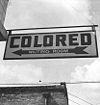
Racist ideologies Acts of racism Crime of apartheid · Hate speech · Institutional racism · Interminority racism · Racial segregation · Racist music · Scientific racism · Slavery · State racismRacial violence Racism against groups Anti-Arabism · Anti-Armenianism · Anti-German sentiment · Anti-Irish racism · Anti-Italianism · Anti-Japanese sentiment · Anti-Korean sentiment · Anti-Mexican sentiment · Anti-Pakistan sentiment · Anti-Polish sentiment · Antisemitism · Racial antisemitism · Anti-Turkism · Anti-Ukrainian sentiment · Antiziganism · Francophobia · Hispanophobia · Indophobia · Lusophobia · Russophobia · Sinophobia · Anti-SlavismRacist groups Heathen Front · Kach and Kahane Chai · Ku Klux Klan · National Party of South Africa · New Black Panther Party · Nation of Islam · · SPLC listAnti-racist groups
and movementsNote: What is considered a human right is controversial and not all the topics listed are universally accepted as human rights.Civil and political Freedom from discrimination · Right to life · Right to die · Security of person · Liberty · Freedom of movement · Freedom from slavery · Personhood · Right to bear arms · Right to equality before the law · Freedom from arbitrary arrest and detention · Freedom from torture · Freedom from cruel and unusual punishment · Right to a fair trial · Presumption of innocence · Right of asylum · Nationality · Freedom from exile · Privacy · Freedom of thought and conscience · Freedom of religion · Freedom of expression · Freedom of information · Freedom of assembly · Freedom of association · Right to protest · Universal suffrage · Marriage · Family life · Same-sex sexual relations
Economic, social
and culturalLabor rights · Fair remuneration · Equal pay for equal work · Trade union membership · Right to social security · Right to rest and leisure · Right to work · Right to property · Right to science and culture · Right to public participation · Right to education · Right to adequate standard of living · Right to housing · Right to development · Right to health · Right to healthcare · Right to water · Right to food · Right of return · Right to Internet access
Reproductive War and conflict Related philosophy Categories:- Crimes against humanity
- Labor
- Slavery
- Slave trade
- Racism
- Abuse
Wikimedia Foundation. 2010.



